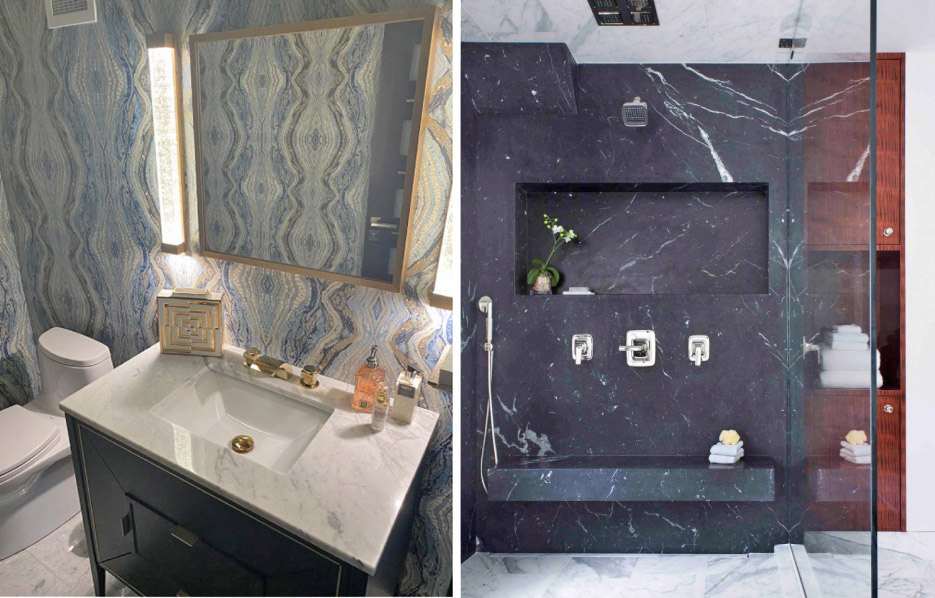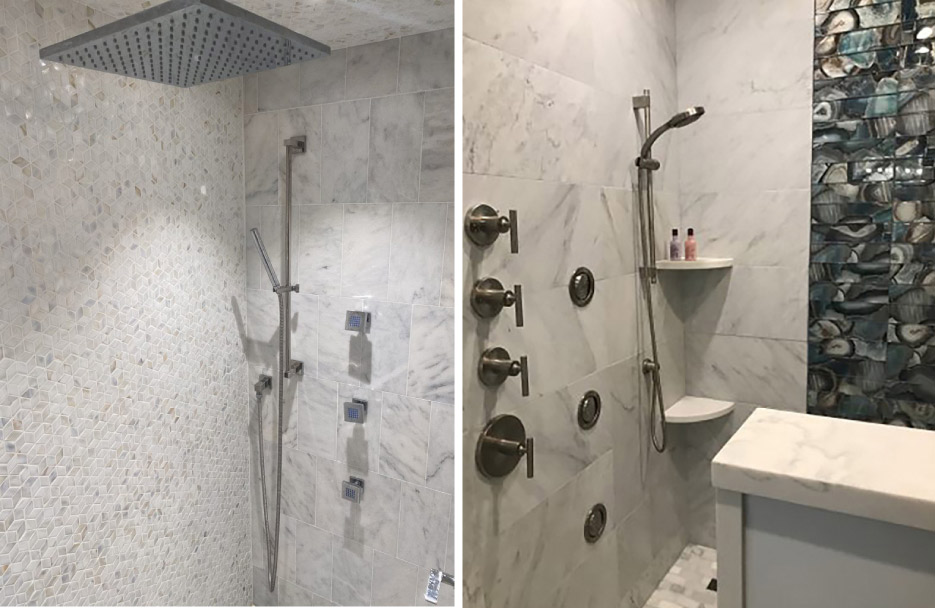Create Bold Bathrooms Using Natural Stone
 Megy Karydes
Megy Karydes
usenaturalstone.com
Photos Courtesy Two Girls and a Hammer and United Marble
Rose Kallas and Christine Morgan, partners and principals of Chicago-based Two Girls and a Hammer LLC, have seen residential design trends come and go. While many classics, like marble, remain popular, the duo is noticing clients asking for more color.
Natural stone is delivering.
“When people think of marble, what often comes to mind is white Carrara,” says Kallas. White Carrara is a beautiful natural stone that is popular in bathroom projects featured in magazines spreads and online. Some clients are stepping out of the box and choosing stone with more color and movement; Kallas has seen clients leaning towards bolder choices, such as black marble with white veining.
“For the past 10 years or so, white and grey have ruled bathrooms and kitchens and now clients are wanting more color in their homes,” Kallas says. She’s seeing more requests for jewel tones including sapphire blue, emerald green, and bright oranges and yellows for cabinets. With that comes the desire for more interesting countertops, backsplashes, and walls.
As a result, Kallas and Morgan admit they’re constantly on the hunt for beautiful natural stone to complement bathrooms with strong colors and features.
For a recent bathroom project featuring wallpaper with a bold design of varying hues of blue, white, grey, and black, they installed a blue vanity with a grey and white veined Carrara marble countertop and blue veined polished Carrara marble flooring. The natural stone doesn’t detract from the focal point of the wallpaper, but it does add to the overall elegant feel of the space.
Color doesn’t always have to be bright and bold to be striking. In another bathroom design featuring more white tones, the team and homeowner opted for natural Mother of Pearl hand cut tile for a feature wall and inside the shower niche, polished white and grey veined Carrara marble was installed for the shower walls and main floor. The shower base features small hexagon grey and white veined Carrara marble.
“The selection of Mother of Pearl was made because of the color variation: grey, white, hints of blue and light beige, which accent the colors of the Carrara [marble],” Kallas says. Since Mother of Pearl comes from the sea, the tiles have shine and reflection that make the shower stand out.
 |
|
Above, left: Carrara marble vanity paired with a colorful wall treatment.
Photo courtesy United Marble. |
Choosing Natural Stone for a Bathroom
When clients come to Two Girls and a Hammer, they usually have a general idea of their design preferences or features they want to incorporate.
“For the blue bathroom, we selected the blue vanity before we chose the flooring material,” Kallas says. “Shortly after we selected the vanity, our supplier started stocking the blue veined Carrara marble. Once we saw the marble sample, the choice of the blue marble was the best fit for the bathroom project.”
Don’t assume that you can’t afford to include natural stone in your project. Kallas and Morgan recommend having a discussion with your designer or contractor: tell them what you love and see if they can source something that will work with your design and budget.
Maintenance shouldn’t be an afterthought when choosing a stone for your bathroom project. Your designer or contractor can make recommendations based on your lifestyle and cleaning preferences. Understanding your stone’s maintenance needs will help ensure that you love your bathroom project for years to come.
Trends in Natural Stone Bathrooms
The biggest trend Kallas and Morgan are seeing is the use of colored marble in bathrooms. In addition to more colors being used, clients are choosing larger format tile on the shower wall or floor, which helps make the shower and floor space look larger. “Tight grout lines make your stone appear as if you have one large sheet of stone as well as easier to clean,” Kallas says.
Some clients who want less maintenance overall are opting for solid sheets of marble for their shower walls so they can avoid grout lines altogether. “Grout tends to hold dirt and appear darker over the years,” Kallas adds.
While more clients are asking for marble and quartzite in their bathrooms, granite still holds a fair share of the marketplace.
 |
|
Above, Left: Carrara marble shower, paired with Mother of Pearl accent tile. Above, Right: Carrara marble and decorative glass feature wall. |
You Can Upgrade a Bathroom Without a Complete Overhaul
An easy way to update a residential bathroom space is by replacing the vanity top. Kallas offers this budget-friendly tip you can pass on to clients: “Many stone fabricators have what we call a ‘bone yard’ where you will find smaller pieces of stone from previous projects. If you are lucky, you will find a beautiful piece of remnant stone perfect for your project at a cost much lower than a regular retailer.”
There is no shortage of places to find inspiration for a bold bathroom design. Kallas recommends homeowners embrace and enjoy the process by going online and checking out design websites. She also recommends walking through big box stores and bath and kitchen showroom displays.
“I highly suggest, before starting a big renovation project, you assemble a mood board with your color palette,” Kallas says. “The paint stores offer color swatches that will make selecting the colors of walls much easier.
Check out fixtures, layout ideas, review your selections months before your initial meeting. Keep adding and subtracting ideas until you finally settle on your ultimate wish list.”
By going through this process in advance, whether the project is small or large, you can present your mood board to your designer or contractor, which will help them better understand the scope of your project.
Megy Karydes is a Chicago-based writer. Find her at MegyKarydes.com .